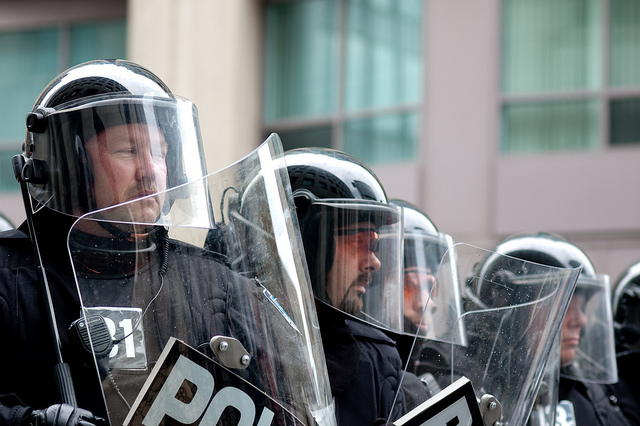Please support our coverage of democratic movements and become a monthly supporter of rabble.ca.
As the World Cup began in Brazil, frightening pictures of hundreds of heavily armoured cops marching through Rio’s streets circulated on social media. These “Robocops” of the Major Events Police Battalion, were part of a special unit developed in response to public demonstrations during last year’s Confederation Cup. Brazilian authorities are using 157,000 security and police officers to avoid any disruption of the high profile event.
It is easy to imagine what this will mean for the poor people and people of colour in Brazil’s World Cup cities — increased police harassment by an increasingly aggressive, well-armed and empowered police.
Although the scale of the operation is different, a similar process of police intervention will become evident, as the Toronto Police Service (TPS) launch an “anti-violence” initiative in the downtown East End of Toronto. In anticipation of the three million participants in this month’s World Pride event, increased numbers of police will be active in the area between Wellesley Street East and Shuter Street, and Church Street and Parliament Street between June 16 and September 8. The operation brings 24 additional constables and 12 staff sergeants to the neighbourhood.
These officers won’t be cracking down on the tourists in town. Instead, it will be the poorest residents of the neighbourhood who will be the target of the TAVIS units. TAVIS or the Toronto Anti-Violence Intervention Strategy was launched by the Toronto police in 2006 in response to a spate of gun violence. The TPS describes it as “an intensive, violence reduction and community mobilization strategy intended to reduce crime and increase safety in our neighbourhoods.” It uses an increased police presence, and “engagement with community members… to deal more effectively with the root causes of crime.”
Despite such a lofty goal — the root causes of crime are unlikely to be affected by increasing police activity in low income neighbourhoods.
The TAVIS website reads “The success of TAVIS is not based on the number of arrests made but on the reduction in crime, enhancement of public trust and confidence, and the building of relationships within the communities most affected by violence.” While the causal relationship between an increased police presence and lowered gun violence is inconclusive, what has been clear is the way its highly visible units primarily engage in the enforcement of minor violations, and that its ‘carding’ operations disproportionately target minorities and poor people. Such operations do not enhance public trust and confidence. Nor do they build communities.
Despite the rhetorical emphasis on relationship building and community, the police is a military-bureaucratic institution whose effects on the root causes of crime are limited. The emphasis of community policing is a velvet glove on an iron fist. In city after city instead of building strong inclusive communities, such initiatives push serious crime underground and result in increased fear, harassment and instability — especially for the most vulnerable.
This is increasingly understood by law enforcement strategists themselves. Noting that community policing initiatives often fail to achieve their goals, the US Justice Department’s Community Oriented Police Services (COPS) program, Senior Policy Analyst Karl Bickel argued in a recent newsletter:
Police chiefs and sheriffs may want to ask themselves — if after hiring officers in the spirit of adventure, who have been exposed to action oriented police dramas since their youth, and sending them to an academy patterned after a military boot camp, then dressing them in black battle dress uniforms and turning them loose in a subculture steeped in an “us versus them” outlook toward those they serve and protect, while prosecuting the war on crime, war on drugs, and now a war on terrorism — is there any realistic hope of institutionalizing community policing as an operational philosophy?
Despite the talk of building relationships with the community, neither Robocops in Brazil nor the TAVIS bike patrols cleansing the Toronto’s Downtown East End for the World Pride will get anywhere near the root causes of crime. Instead, as both cities prioritize the needs of wealthy tourists over the needs of low income residents; and use police units to respond to poverty and homelessness, we’re likely to see more fear, more marginalization and more police violence.
Lesley Wood is Associate Professor of Sociology at York University. She is the author of Crisis and Control: The Militarization of Protest Policing (Pluto Press, 2014.)
Photo: flickr/Jason Hargrove



